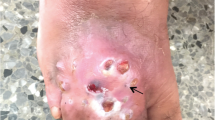Summary
Two cases of Madura foot which originated in the Middle East are described. This so-called maduramycosis is a chronic progressive infection caused by thread fungi or actinomycetes. The diagnosis is confirmed when the grains of mycetoplaits are demonstrated in the discharge from a sinus. Clinical findings and treatment are discussed. Medical treatment may be needed for several months, but operation is indicated for infections caused by the true fungi (eumycetoma).
Résumé
Présentation de deux cas de pied de Madura originaires du Moyen-Orient. Cette maduramycose est une infection chronique progressive due à des filaments mycéliens ou actinomycètes. Le diagnostic peut être affirmé lorsqu'on met en évidence dans l'écoulement s'évacuant par les fistules des grains constitués d'amas de filaments mycéliens. Les constatations cliniques et le traitement sont discutés. Le traitement médical doit parfois être poursuivi plusieurs mois, mais une intervention chirurgicale peut être indiquée en présence d'infections dues à de véritables mycoses (ou eumycétomes).
Similar content being viewed by others
References
Curtin JW (1965) Fibromatosis of the plantar facia: surgical technique and design of skin incision. J Bone Joint Surg 47 (Am):1605–1608
El Sheikh Mahgoub (1977) Clinical Aspects and Treatment of Mycetomas and Various. Infections due to Nocardia spp. In: Fropenmedizin und Parasitologie, Bd 28:277. Thieme, Stuttgart
Enyinnaya Nnochiri (1979) Textbook of Imported Diseases: 201–205. Oxford University Press
Grigoriu U, Delacretaz J, Borelli D (1984) Lehrbuch der medizinischen Mykologie. 433–442. Huber, Bern
Hay RJ, Mackenzie DW (1983) Mycetoma (madura foot) in the United Kingdom: A Survey of forty-four cases. Clin Exp Dermatol 8:553–562
Mackenzie DW (1984) Hunter's Tropical Medizine:438–442. W. B. Sounders, Philadelphia
Pentland AP, Anderson TF (1985) Plantar fibromatosis responds to intralesional steroids. J Am Acad Dermatol 12:212–214
Reifferscheid M, Seeliger HPR (1955) Monosporiose und Maduramykose. Dtsche Med Wschr 80:1841–1843
Seeliger HPR, Heymer T (1981) Diagnostik pathogener Pilze des Menschen und seiner Umwelt:159–188. Thieme, Stuttgart
Turner PG (1989) Madura foot or plantar fibromatosis. J Bone Joint Surg 71 (br):531
Utz JP, Hoeprich PD (1983) Infections diseases, 3rd edn. Harper & Row, Philadelphia, pp 1331–1333
Author information
Authors and Affiliations
Rights and permissions
About this article
Cite this article
Suttner, JF., Wirth, C.J., Wülker, N. et al. Madura foot. International Orthopaedics 14, 217–219 (1990). https://doi.org/10.1007/BF00180132
Issue Date:
DOI: https://doi.org/10.1007/BF00180132



